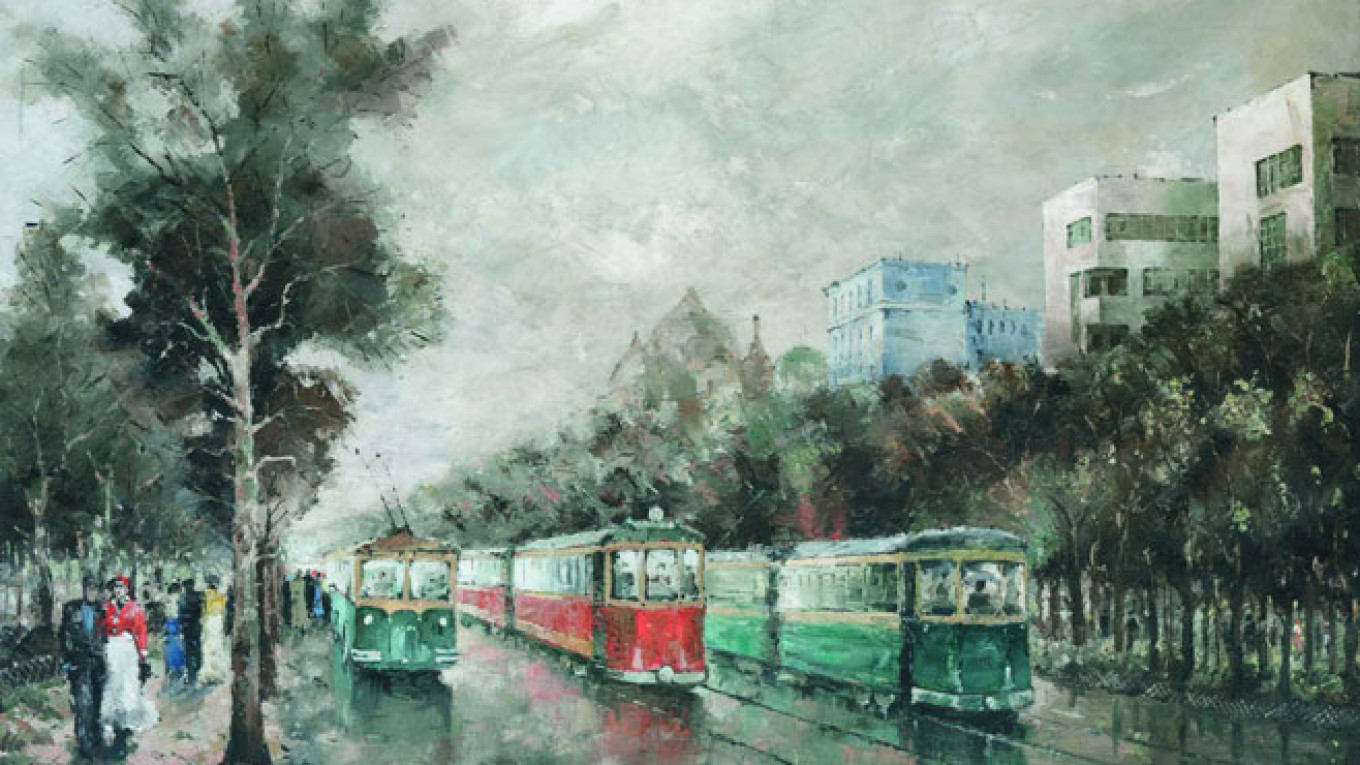It is fitting that an exhibition about the impact of travel and transportation on Russian life should itself undertake a physical journey. “Russia on the Road. Planes, Trains and Automobiles. 1920–1990” had its debut in one of Rome's major exhibition centers, the majestic Palazzo delle Esposizioni, last October. The artworks have now traveled back home to Russia, where they will be on show until May 22 at the Institute of Russian Realist Art (IRRA) in Moscow.
A Journey Through History
The exhibition comprises around 60 pieces divided into four sections: Planes, Trains and Automobiles, Love and Machines, Wild Russia and The Space Race. Each holds artworks by renowned 20th century artists including Alexander Deyneka, Yuri Pimenov, Alexander Samokhvalov and Georgy Nissky.
The exhibition spans a period of time beginning with the 1917 Revolution, which catalyzed change across all areas of Russian cultural life. It then passes through the post-war years and the 50s, moving through Khrushchev's thaw and the associated scientific research period of the Soviet space program that characterized the 60s. The exhibition neatly showcases how Soviet Russia developed its industries, tried to get into the air, and into space, and developed transportation over its vast territory. Much of the artwork depicts the beauty and harmony of man and machine working together.
A Collaborative Effort
The exhibition is a collaborative effort between Russia and Italy, conceived by collector Alexei Ananiev and jointly curated by art director of the IRRA, Nadezhda Stepanova, and Matteo Lafranconi from the Palazzo delle Esposizioni.
Organizing an exhibition across two continents required a cultural understanding of the expectations of both audiences. An exhibition of socialist realist paintings in Italy provided a unique opportunity for visitors to gain an insight into life in the Soviet Union, while giving Russian socialist realism a greater profile abroad. ?€?I feel that for Italian visitors it was very important that paintings were dynamic, full of energy, bright and inspirational. And of course people were interested in details of Soviet life routine — what were Soviet people wearing, what were they driving, where did they travel, what did they dream about,?€? Nadezhda Stepanova told The Moscow Times. ?€?Surprisingly, Italians didn't find any whiff of propaganda in our artworks. Predominantly they were impressed by the excellence of the artists presented at our exhibition.?€? Stepanova believes that ?€?Russia on the Road?€?is not simply a history of transport. ?€?For the Russian audience the artworks on display are also a document of the age,?€? she said.
Visitors to the exhibition in Italy commented on their surprise at Soviet-era artwork on display in Italy as well as the unique nature of the collection when compared to the many other exhibitions of European art. While some remarked that the paintings had made them reflect on some of the more tragic elements of life in the Soviet Union, others found the paintings unexpectedly touching. A similar positive response has so far prevailed in Russia. Written remarks in the guest book of the Moscow exhibition show how visitors have felt encouraged to further explore 20th century art, and even travel more.
A Cross-Cultural Exchange
The debut of "Russia on the Road" is not the first time Russian art has made its presence felt in Italy. In 2011, the Palazzo delle Esposizioni hosted three Russian art exhibitions ?€” "Socialist Realism," "Rodchenko" and "Alexander Deyneka." While socialist realist art is certainly less well known overseas, cross-cultural exchanges have clearly given Italians a taste for Russian art, particularly that of the 20th century. The Alexander Deyneka exhibition one of the most popular exhibitions in Rome of 2011, and the success of ?€?Russia on the Road?€? indicates similar projects will be well received by both countries.
Speaking about the project, Stepanova commented: "True art is global and universal. Our exhibit was especially relevant for the Italian audience as some of Soviet artists in the middle of 20th century were inspired by Italian neo-realism." Matteo Lafranconi, the scientific and cultural activities manager of the Palazzo delle Esposizioni and a Soviet art enthusiast, underlined how popular the exhibition had proven in Rome. Several times Russian colleagues were asked to extend the exhibition in Rome due to the demand of the audience and the precious opportunity to display the unique paintings.
In the artworks visitors can discover both the realism of Russian painting in the mid 20th century and the impressionist elements that inspired many of the artists. The paintings of a unique insight into life behind the Iron Curtain. Strolling through the rooms of the IRRA, as well as in the Palazzo delle Esposizioni, it is difficult not to be impressed by the immense changes transportation has brought about in Russia and more widely in the modern world.
Having achieved resounding success in just its three months exhibition period in Rome, ?€?Russia on the Road?€? looks to conquer its homeland, Russia, as well.
Institute of Russian Realist Art
rusrealart.ru
7 Derbenevskaya Naberezhnaya. Metro Paveletskaya, Proletarskaya
A Message from The Moscow Times:
Dear readers,
We are facing unprecedented challenges. Russia's Prosecutor General's Office has designated The Moscow Times as an "undesirable" organization, criminalizing our work and putting our staff at risk of prosecution. This follows our earlier unjust labeling as a "foreign agent."
These actions are direct attempts to silence independent journalism in Russia. The authorities claim our work "discredits the decisions of the Russian leadership." We see things differently: we strive to provide accurate, unbiased reporting on Russia.
We, the journalists of The Moscow Times, refuse to be silenced. But to continue our work, we need your help.
Your support, no matter how small, makes a world of difference. If you can, please support us monthly starting from just $2. It's quick to set up, and every contribution makes a significant impact.
By supporting The Moscow Times, you're defending open, independent journalism in the face of repression. Thank you for standing with us.
Remind me later.


